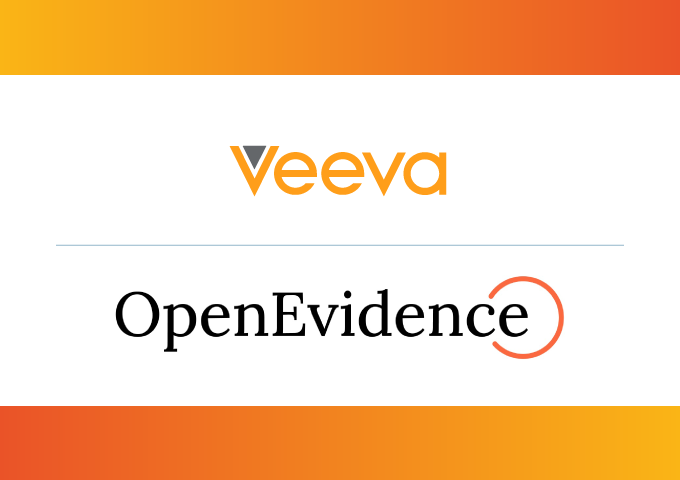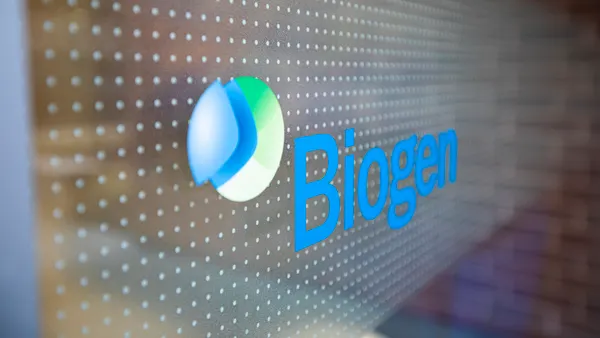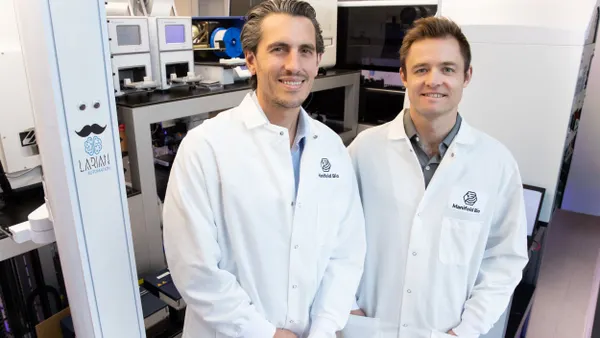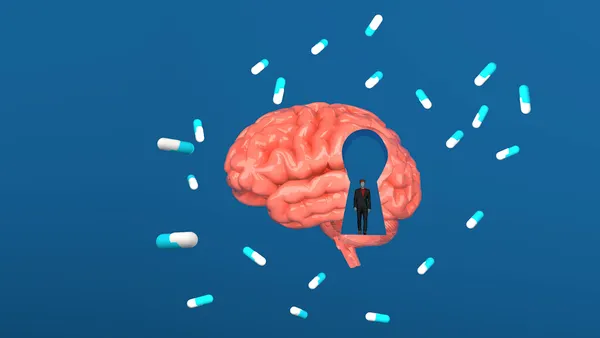Arthur Higgins – Vision, Passion, and Commitment By Kim Ribbink In each major step of his career, Arthur Higgins has helped to turn around divisions and companies. Now he faces his next challenge – reinvigorating Bayer HealthCare. If history is anything to go by, Bayer has a leader who is up to the task. For Bayer HealthCare, Arthur J. Higgins, 48, might be just what the doctor ordered. Mr. Higgins, the recently appointed chairman and CEO of Bayer HealthCare, has made a career of helping companies and divisions overcome challenges and ultimately to excel. He joined the company May 10, 2004, succeeding Rolf Classon, who retired after 13 years of service with Bayer. Mr. Higgins attributes his success to the multiple exciting opportunities he has been presented with during his career and being able to learn from those experiences. “All through my career I’ve been faced with a need to deal with change, to quickly assess new situations, and to exhibit a high level of adaptability and flexibility to find that right solution to whatever opportunities are presented to me,” Mr. Higgins says. “Thanks to those experiences, today I’m seldom, if ever presented, with a situation I’ve not previously had to deal with. People give me credit for being quick to assess new situations, but it’s a lot easier to be quick and smart when one’s been around the block a couple of times. I don’t think I’ve been presented with a situation in the last couple of years that I haven’t had to deal with at least once or twice in my career. I often smile when people think an issue or a problem is new; there is nothing new. If you’re around long enough you’ll have seen everything more than once.” His career has taken him around the world, including Europe, North America, Latin America, and Asia, at a diverse selection of healthcare companies, namely Bristol-Myers, Sandoz, Abbott Laboratories, and Enzon Pharmaceuticals. At Abbott, Mr. Higgins helped to turn around the company’s pharmaceutical business in the United States, which today is the fastest growing and most profitable of Abbott’s businesses. In less than three years, he helped turn Enzon from a company of 86 employees with revenue of $30 million to a company of about 360 employees with revenue of $180 million. Now this international leader is taking his shrewd business mind to Bayer HealthCare, the healthcare division of the German science conglomerate Bayer AG. Undoubtedly, the company will benefit from Mr. Higgins’ drive, but also from the fact that he never rests on his laurels. “A lot of my drive, my enthusiasm, and my energy come from the fact that I really do believe I can do a better job tomorrow than the job I’ve already done well today,” Mr. Higgins says. “I never take anything for granted. I’m always ready for the fight, the next challenge, and finding the next opportunity. My greatest professional concern is that I relax and miss a transforming opportunity.” It’s this outward focus that will serve Bayer HealthCare well as the company addresses its market challenges. The Pure Science of Business An early love of biology and chemistry while attending high school in his native Scotland drew Mr. Higgins to studying for a degree in biochemistry. From the start, his interest was in the application of science, and it was this that led him to Strathclyde University in Scotland. “Strathclyde University appealed to me because of its growing reputation at the time in applied biochemistry, with a particular focus to industry,” he says. Despite being drawn to practical science, Mr. Higgins says he quickly realized his skills did not lie in being a bench scientist, but rather on the business side, beginning as a pharmaceutical sales rep. “I realized early on that I was too impatient and outgoing to be a great bench scientist,” he says. “Pharmaceutical selling allowed me to use my science background as well as my strong interpersonal skills. The other interesting thing is that as a sales rep, I had more autonomy than I’ve ever had in my career, even now. As a sales rep you are there by yourself to make decisions. You determine what the customer needs are, you determine who your high prescribers are, and it’s your personality and product knowledge that distinguishes you. You do this without the involvement of anyone else. Business won and lost comes down to the individual and this taught me a lot of independence and built attributes that I’ve taken with me as I’ve managed larger and more complex businesses. I often remind sales reps – and I’ve managed thousands and thousands of reps – that they form the basis of their business skills out in the field.” Mr. Higgins has needed little prodding from others to achieve. “I’ve always been a bit of a self-starter,” he notes. “I’ve never really needed much encouragement. I absorb every situation and learn from everybody that I’ve come into contact with.” That self motivation helped Mr. Higgins rise quickly from the field to management to leading divisions and, ultimately, companies. He attributes his success in the field to adhering to three principles, which also have helped guide him in other aspects of his career. “The first is to understand your customers; the second is to identify those customers with the highest needs and potential to use your products; and the third is sales reps and companies have to focus on distinguishing themselves among those high potential users,” he says. “These three principles are still central to the way I operate because they represent the principles of customer focus, segmentation, and superior competitiveness. I believe these principles apply regardless of whether one is managing a sales territory or running a large company.” Diversification Personified After working at several pharmaceutical companies in the United Kingdom, Mr. Higgins joined Abbott Laboratories in 1987. “I never wanted to be niched as a pure pharma executive, but rather as a broad-based healthcare executive,” he says. “This is one of the reasons Abbott appealed to me, because it was a diversified company.” During his 14-year career at Abbott, Mr. Higgins oversaw the pharmaceutical business in the United States as well as global pharmaceutical research and development, including 6,500 staff, of which 2,000 were scientists and physicians. He improved R&D productivity by reducing the number of therapeutic areas and significantly increased the size of the sales and marketing organization to improve its competitiveness. He also was responsible for in-licensing four products that generated more than $1 billion in sales. He played a key role in the acquisition and integration of BASF Pharma and spearheaded the unsuccessful attempt to acquire Alza (which was abandoned as a result of FTC concerns; Alza subsequently became a member of the Johnson & Johnson family of companies in 2001). He also led the accelerated approval and launch of Kaletra, a HIV protease inhibitor, and the launch of Tricor, a cholesterol-lowering agent. Both products have proven to be big winners for Abbott in the United States. Furthermore, he successfully managed a major product withdrawal and the loss of $650 million in sales to generics. In addition to being exposed to a wide range of healthcare operations, including pharmaceuticals, diagnostics, consumer products, and hospital devices, he also had the opportunity to work in all of the major geographic areas. “Before running Abbott’s pharmaceutical business in the United States, I had responsibility for all of Abbott’s businesses in Asia, including Japan,” he notes. “I also had responsibility for several European markets and in my role in international business development, I spent quite a bit of time developing business plans and strategies for Latin America.” Mr. Higgins was responsible for the successful launch of clarithromycin, marketed in the United States and elsewhere as Biaxin. “I was responsible for the initial launches of that product, which became Abbott’s single largest pharmaceutical product, and I believe it still is today,” he says. Beyond product-specific involvement, Mr. Higgins also played a leadership role in Abbott’s strategy for emerging markets, including India, China, South Korea, and Vietnam. “I think I can say with all modesty that because of my initiative these are now significant businesses for Abbott,” he says. On an even larger front, Mr. Higgins led the turnaround of Abbott’s pharmaceutical business in the United States. “I took over the pharmaceutical business at a time when it faced a lot of challenges,” he notes. “But today that is the fastest growing and most profitable part of Abbott’s business, and I think I can take some small credit for that.” Having made such a significant mark on Abbott’s operations during his years at the company, Mr. Higgins sought to apply those skills to a small, entrepreneurial company. In 2001, he joined Enzon as chairman and CEO. “I had a very clear goal, which was to transform Enzon from a small, specialty company into a fully integrated and sustainable biopharmaceutical company,” he says. “I believe I successfully achieved that goal over the past three years.” While at Enzon, he was instrumental in raising more than $400 million through convertible notes, forming three major strategic alliances, and acquiring three marketed products. Mr. Higgins maintains success in the pharmaceutical sector is built on three pillars. The first, he says, is to build a research and development group that is productive and can develop products that drive future revenue. The second is to focus on attracting good partnerships, since 50% or more of a company’s product revenue comes from acquired or in-licensed products. The third is to ensure that a sales and marketing organization is in place that can help the company distinguish itself in a competitive market. “Enzon demonstrated that it could do all three of those things,” Mr. Higgins comments. “While there is still a lot to be achieved at Enzon, I think the building blocks are now firmly in place. The company has capabilities that span from preclinical to development, manufacturing, sales and marketing, and licensing, which is very uncommon for a company of its size. I’m most proud of how well positioned Enzon is for the future.” Though he steps down as CEO of Enzon, Mr. Higgins maintains close ties to the company, continuing in his role as chairman of the board as he looks forward with anticipation to his next test, as CEO and chairman of Bayer HealthCare. “I’ve been fortunate to have been presented with a new challenge every two to three years,” he says. “Each step gave me expanded responsibilities, and with those expanded responsibilities came new challenges to address. Those challenges could range from having to understand a new therapeutic area, a new geography, a new organization, or a new business function, such as manufacturing, research and development, finance, as well as the opportunity to deal with fast-growing brands or mature brands that were declining.” A Focus on Strength The appeal of Bayer HealthCare, Mr. Higgins says, is the fact that, like Abbott, it is a diversified healthcare company. Aside from pharmaceuticals, the company develops biotech products, consumer products, diagnostic products, and animal-health products. “Pharmaceutical companies are challenged with dealing with the peeks and troughs; when products go generic or the R&D pipeline slows down, pure pharma companies experience a lot of volatility,” he says. “Diversified healthcare companies can leverage their other businesses and geography to reduce the volatility typically associated with a pure pharmaceutical company.” Undoubtedly, Bayer HealthCare has had some battles to contend with (the withdrawal of Baycol) and continues to face some difficult challenges (major product launches and now generic forms of Cipro). The company has been especially hurt by the 2001 withdrawal of its cholesterol-lowering drug Baycol, known as Lipobay in Europe. The company voluntarily withdrew the drug following reports of sometimes-fatal rhabdomyolysis, a severe muscle disorder. Bayer was subsequently hit with a large number of litigation cases, which began in the United States. In his annual address on April 30, 2004, Werner Wenning, chairman of Bayer AG, Bayer HealthCare’s parent company, announced the company had taken a charge of 300 million euros ($365.1 million) in accounting measures related to the Baycol litigation. The company says it has so far settled 2,312 Baycol cases worldwide at a cost of $872 million without admission of liability. As of April 23, 2004, there were 9,278 cases pending. The company also has watched its market share of the anti-infective Cipro drop in the United States because of generic competition. While the company does face challenges, they are similar to those Mr. Higgins faced at Abbott when he took over the pharmaceutical business. “I’m not entering uncharted waters; these are challenges that are familiar to me,” he says. While there are no magic recipes to ensure Bayer’s future growth, Mr. Higgins notes he does have a strategy. “I have to ensure that each of the businesses has a sustainable vision for growth,” he comments. “That growth, both in revenue and income, has to be set at a level that is at least at, and in my opinion should be above, industry average. We need to ensure that our people, products, and processes are truly best in class.” Despite recent events, Bayer HealthCare has plenty in its arsenal to weather the storm. According to company statements, Bayer HealthCare launched nine new products last year, which generated additional sales of 650 million euros ($791.1 million). The company’s erectile dysfunction drug, Levitra, captured a 16% share of new prescriptions in the United States. A significant part of its future is the company’s heritage and the fact that the name Bayer is known internationally, Mr. Higgins says. “Bayer Aspirin, for example, is probably one of the top recognized healthcare brands in the world,” he says. “Given that Bayer is a company with great brand recognition, one of the opportunities we have is to take advantage of that brand and the confidence that gives our customers.” Corporate branding, Mr. Higgins believes, probably holds less benefit for a pure play pharmaceutical company, but for a company such as Bayer with a heavy consumer orientation, a strong brand is critical. “Corporate awareness and corporate reputation are of great value to us, and certainly something that as a company we’ve been investing in,” he says. “Bayer has the strategic advantage of being a recognized corporation that’s held in very high regard. Finding new ways to leverage that advantage is one of my goals.” The company’s size also is an asset that can be leveraged for future success, Mr. Higgins notes. “Since Bayer HealthCare’s pharmaceutical business is midsize – and by midsize I don’t mean mediocre – I mean it’s not burdened with the scale, and perhaps the inertia, of larger pharmaceutical companies,” he says. “In many ways, the right entrepreneurial spirit, which I believe already exists at Bayer, provides a greater ability to drive revenue and income at a much faster rate than traditional big pharma. Very simply, because we’re not burdened by the laws of big numbers, sustainable growth is an achievable goal.” Going forward, Mr. Higgins says a healthy pipeline will continue to sustain the company. In particular, he says two products in development have garnered a great deal of interest: a Raf kinase inhibitor f r the treatment of kidney and other cancers, which is in Phase III clinical trials; and a Factor Xa inhibitor, which is an oral anticoagulant in Phase IIb trials for the prevention and treatment of thrombosis. The Raf kinase inhibitor, which is being developed jointly with Onyx Pharmaceuticals Inc., has been granted fast-track status by the Food and Drug Administration. Mr. Higgins says as he works to take Bayer HealthCare forward, he will draw on some of the lessons that he learned at Abbott and Enzon. “It is important to have a clear vision and strategy that everyone can believe in, feel passionate about, and be totally committed to,” he notes. “As a leader, it is important to set high standards and not accept compromise. Perhaps the final lesson is that success in business is less about the big bold idea, and much more about delivering on a commitment. I’m a firm believer that business is all about execution. Too many people get seduced by that big idea and forget that without the execution, that idea has no value.” F PharmaVoice welcomes comments about this article. E-mail us at [email protected]. Success in business is less about the big bold idea, and much more about delivering on a commitment. I’m a firm believer that business is all about execution. Too many people get seduced by that big idea and forget that without the execution, that idea has no value. Putting a Conglomerate in Order Over the past two years Bayer AG, the German science conglomerate and parent of Bayer HealthCare, has been undergoing a companywide reorganization to equip it for the future. Bayer chairman Werner Wenning, in his annual address to stockholders this year, said the company would place its focus on three areas: healthcare, nutrition, and high-tech materials. As part of the reorganization, Bayer has devised a new international slogan: Bayer – Science for a Better Life. The company’s chemical operations and a third of the polymers business have been spun off into a separate business, Lanxess, which is scheduled to be listed on the stock market by 2005. Bayer experienced a slight decline (4%) in sales in 2003 to 28.6 billion euros ($34.8 billion), which the company attributes in large part to currency effects. On a positive note, Mr. Wenning pointed to increases in operating results before special items, improved cash flow, and a better-than-expected debt reduction. He acknowledged, however, that the year was far from ideal. Difficulties included increases in raw material and energy costs, which hurt Bayer’s industrial businesses, and other special items, which caused a loss of 1.2 billion euros ($1.46 billion) in earnings before interest and taxes (EBIT). These items included realignment charges, restructuring, and the cost of out-of-court settlements arising from the Baycol recall. The company had originally planned to eliminate 15,000 positions by 2005. Bayer reached an agreement with employees to forego up to 10% of variable income. This applies to all employees, from skilled workers to the board of management. This has enabled the company to reduce the number of job cuts to 14,000. At the end of 2003, 9,300 positions had been eliminated. Going forward, the company is focusing its resources on its HealthCare, CropScience, and MaterialScience businesses. The company plans to invest 2.3 billion euros ($2.8 billion) in research and development this year. The HealthCare and CropScience businesses account for 85% of this R&D spending. For the group as a whole, including Lanxess, Mr. Wenning notes that the company expects to improve the operating result before depreciation and amortization, EBITDA, by more than 10% in 2004. In its HealthCare portfolio, the company expects EBITDA to increase 17% by 2006, held back by declines in Cipro sales from generic competition. But Mr. Wenning said he expects strong pipeline developments to boost performance in the medium term. In 2003, the company launched nine new products that generated 650 million euros ($791.1 million). Sales in the pharmaceutical/biologics products segment grew 11% over 2002 before currency translations; sales in consumer care products increased 12% over the year before portfolio and currency effects; and sales in diagnostic products grew by 5%. The animal health business grew 5% in 2003. The company is continuing to evolve the pharmaceuticals business with a more focused effort on anti-infectives, cardiovascular risk management, urology, and cancer research. In CropScience, Mr. Wenning said Bayer plans to attain a 25% EBITDA margin by 2006, helped by acquisitions and a strong pipeline. Sales in 2003 grew by 23%, largely as a result of the Aventis CropScience acquisition. In MaterialScience, Bayer plans to achieve an EBITDA margin of 18% by 2006. Bayer Pharma’s Research Pipeline Compound Indication Status Raf kinase inhibitor Cancer Phase III Factor Xa inhibitor Cardiovascular Phase IIb Repinotan (branosyn) Stroke Phase IIb Taxane Cancer Phase II 11 projects Phase I 18 projects Preclinical Source: Bayer AG, Leverkusen, Germany. For more information, visit bayer.com. Leading by Example In an exclusive interview with PharmaVOICE, Arthur Higgins, chairman and CEO of Bayer HealthCare, talks about the way he leads, what motivates him and keeps him going, and the difficulties he believes the industry faces. How would you describe your leadership style? Success comes from attracting and retaining the brightest and best people and then giving those people the leadership and resources to be successful. That is a clichÈ, but it is true. I’ve never been afraid to bring on people who would challenge me or could even replace me. I believe in leading, and not in managing. If the right people are in place and have the right resources, they will deliver results. What do you believe is the mark of a great leader? To me, a leader is someone who can focus on the real drivers of value and establish successful strategies and tactics to realize that value. A leader is absolutely honest and open with those who are around him or her. A leader focuses on issues not politics. Leaders should be able to have fun and laugh at themselves when appropriate. That’s what I expect from leaders, that’s what I look for in leaders, and that’s what I strive to do myself. Leaders create a culture where people love winning more than they fear losing. In most companies, people are too afraid of making mistakes and, as a result, they don’t achieve their full potential. Can you talk about individuals who have inspired you and led you to where you are today? I’ve been fortunate to work for so many great people that it would be difficult to single out anyone in particular. I know if I did that, I’d have another half a dozen people who would feel disenfranchised. There are so many people who have taught me the principles that have helped me to be a leader, and I’ve tried to adopt these principles in my own leadership style. What are some of the most pressing challenges facing the industry? And what are some ways industry leaders such as yourself can address and overcome those challenges? There are many threats facing our industry. There is the risk of drug imports from Canada and abroad; the threat of eventual price controls in the United States; the escalating cost of R&D coupled by an alarming fall in R&D productivity; and crippling costs, particularly in the United States, related to lawsuits following product withdrawals. But to me, the most alarming and the most disappointing issue is that as an industry we’ve lost the trust of the patients whose lives we save, of the physicians who we provide new and enabling services to, and the government and the private insurers who reimburse our products. It’s sad that for an industry that does so much good that we now have a lower public image than the tobacco or oil industries. The greatest challenge facing me and other healthcare executives is to rebuild the reputation of this great industry. How do you start your day and how do you unwind? An ideal day for me would be to start at 7:30 a.m. with half an hour to an hour of quiet time to review priorities before the whole chaos of the day and the endless meetings and decision making gets under way. Then, if possible, I like to finish around 6:30 p.m. to 7:00 p.m. and spend an hour in the gym. I believe that to keep up with the challenges of running a business it’s important to be physically tough, so physical fitness is important to me. Of course, the ideal day seldom happens, but it’s what I strive for. A Lifetime of Progress ArTHUR HIGGINS – Resume May 2004 – Present. President and CEO, Bayer HealthCare, Leverkusen, Germany June 2001 – Present. Chairman, Enzon Pharmaceuticals, Bridgewater, N.J. May 2004 – June 2001. CEO and Chairman, Enzon Pharmaceuticals, Bridgewater, N.J. June 2001 – Jan. 1998. President Pharmaceutical Division, Abbott Laboratories, Abbott Park, Ill. Jan. 1988 – Nov. 1996. VP, Pacific/Asia/Africa Operations, Abbott Laboratories, Abbott Park, Ill. Nov. 1996 – Dec. 1994. VP, Pacific/Asia/Africa, Abbott International Division, Abbott Park, Ill. Dec. 1994 – Dec. 1993. VP International Business Development, Abbott Laboratories, Abbott Park, Ill. Dec. 1993 – July 1992. Regional Director Europe, Africa and Middle East, Abbott Diagnostics, Abbott Park, Ill. July 1992 – March 1991. Commercial Director Europe and Regional Manager, Northern Europe, Abbott Laboratories, Abbott Park, Ill. March 1991 – Dec. 1989. Commercial Director Europe, Abbott International USA, Abbott Park, Ill. Dec. 1989 – Aug. 1987. Pharmaceutical Division Manager, Abbott Laboratories, Abbott Park, Ill. Aug. 1987 – April 1984. Marketing Manager, Fison, United Kingdom April 1984 – Jan. 1982. Ethicals Manager, Dorsey Laboratories, Sandoz, United Kingdom Dec. 1982 – Sept. 1979. Product Manager, Sandoz, United Kingdom Sept. 1979 – June 1978. Hospital Representative, Mead-Johnson Division, Bristol-Myers, United Kingdom EDUCATION: B.Sc., Honors Degree in Biochemistry, Strathclyde University, Scotland ASSOCIATIONS: Chairman of the Biotech Council of New Jersey Board member of the U.S. National Pharmaceutical Council A lot of my drive, my enthusiasm, and my energy come from the fact that I do believe I can do a better job tomorrow than the job I’ve already done well today.
An article from


Arthur Higgins: Vision, Passion & Commitment
Filed Under:
Research & Development









